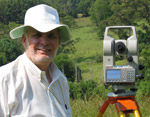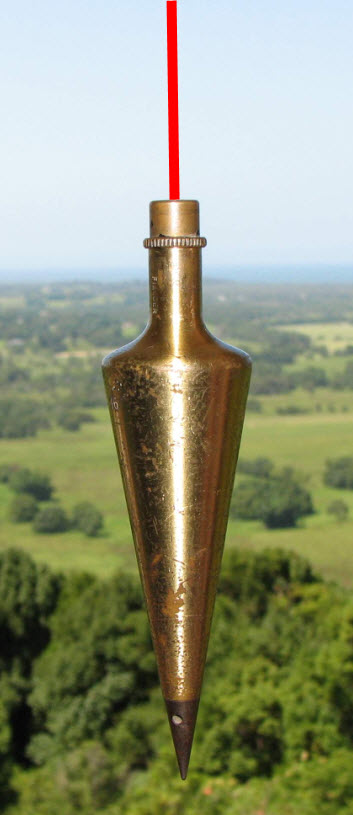Land boundary reinstatement and survey costs
A non-technical explanation for the land owner or purchaser.
“The true nature of the boundary surveyor’s role lies not in theories of exact measurement, but in the proposition that the basic determinant of the limits of any region in respect of which some person or body holds exclusive legal rights, is not a matter of surveying, but a matter of law.”
Frank M. Hallman, 1973, ” Legal Aspects of Boundary Surveying as apply in NSW.”
Land survey costs are influenced by the age of original land survey information, being public records of land title and plans of survey, the property size, shape and value, liability exposure for the Surveyor, the topography, the terrain and vegetation of the land parcel itself, accessibility to the property corners and importantly, any existing evidence on the ground, of land boundary survey monumentation. ie. Objects or marks, shown in the original registered plan of survey that are related to the land boundaries. These ground markings are known as monuments. Where monuments are gone or disturbed, the field survey component for a property survey is generally required to be extended, until reliable survey markings are found.
I advise that survey costs are dependent, in part, upon the necessary background research required for the land parcel itself and the extent of ground field survey and survey computations required to properly re-establish the original land boundaries. The total effort and time involved necessarily reflects the cost.
The actual investigative land surveying process is known as the land boundary reinstatement.
The process starting point is the Certificate of Title, CT, of the subject property, which nominates the title diagram. This diagram shows boundary lengths and bearings for the subject lot and adjoining lots. In NSW this is usually a numbered Deposited Plan of Survey, DP, detailing lot(s) in a dimensioned plan of land subdivision.
The DP can be a plan of actual survey of land or a compiled plan, meaning a plan of land where some or all of the shown boundary measurements have been adopted from previous survey information, without further survey on the ground. If the property CT is based on a compiled plan(s), it is prudent to obtain the original surveyed DPs used in the compilation preparation.
The metes and bounds – mathematics and land boundary markings.
The NSW DP, plan of survey, is a plan of mathematical integrity and is able to be checked for reliability. Dimensions shown, being bearings and distances of lot land boundaries, can be tested for correctness and accuracy by survey closure computation. This mathematical framework is known as the metes.
At the initial time of marking of an original land survey or land subdivision, as well as the placement of boundary corner and line marks, reference marks to corners are also placed to facilitate future land boundary reinstatement. An additional layer of reference marking to land boundary corners are mandatory surveyed connections to found and placed NSW state control survey marks, referred to as the NSW Survey Control Information Management System, SCIMS.
Features and survey markings that reliably anchor the metes to the ground are known as the bounds. In common law, the evidence of the bounds generally carries more weight than the metes. Hence the land surveyor’s adage - monuments before measurement. In modern NSW cadastral survey practice, the metes and bounds are usually in agreement.
The COGO mathematical model and the original plan of survey.
COGO software is a suite of programs used for solving coordinate geometry problems as applicable to land surveying. Computations are undertaken in a precision drawing environment with the capability of exporting data to an enhanced CAD format.
Through the COGO computation process, a mathematical model of coordinates on a local datum can be determined for relevant lot corners, reference marks and control points shown in a DP plan of survey for the land boundaries being investigated. These generated coordinates taken from the tested original plan of survey, are utilised to validate evidence found in the subsequent field measurement survey.
Field measurement survey on the ground.
For a particular property survey, be it urban or rural land, initially, any relevant evidence of prior land boundary monumentation is searched for and located on the ground. For example and not limited to - old survey pegs and associated reference marking, old original fencing or SCIMS survey control points.
These found monuments are surveyed, measuring bearing and horizontal distance by closed traverse and checked radiations, utilising precision total station surveying equipment or if appropriate, by high precision GPS equipment.
Using COGO and on a different coordinate datum to the original plan of survey, checked coordinates are determined for the monuments located and found on the ground in the field survey.
Original plan and field survey measurement comparison.
Two separate mathematical coordinate models are now available for original plan and field survey comparison assessment. The bearing and distance between monuments found can be compared against bearing and distance computed from the original survey plan. An evaluation can then be made as to which monuments are to be adopted as reliable and correct, or which to reject. Based on acceptable evidence of monumentation, land boundaries are reinstated on the ground to the location where they were originally surveyed.
Utilising adopted proven monuments, the separate coordinate models are now able to be merged by rotation and translocation, bringing the original plan of survey and field traverse survey together into one mathematical coordinate model. This will now facilitate, if necessary, the finding of further monumentation to prove a land boundary, the marking of a land boundary or the relating of an existing building structure to a boundary.
The Registered Land Surveyor’s responsibility.
The American surveying authority, Curtis M. Brown, sums up the reinstatement process as follows, “The duty of the surveyor is to locate the lines exactly as run by the original surveyor and to gather sufficient evidence so that a judge and jury can be convinced that the re-established line is the original line run by the original surveyor.” (Frank M. Hallman, ibid)
Should you have any uncertainty about the correct location of a land boundary on the ground, I offer, as an experienced New South Wales Registered Land Surveyor, personal professional service and expert friendly advice.
NEW SOUTH WALES NORTHERN RIVERS REGION - AUSTRALIA
BYRON BAY – BANGALOW – MULLUMBIMBY – BRUNSWICK HEADS – ST. HELENA – OCEAN SHORES – FEDERAL – WILSONS CREEK – BALLINA – LISMORE – TWEED HEADS – MURWILLUMBAH – LENNOX HEAD – TINTENBAR – CLUNES – BEXHILL – COORABELL – POSSUM CREEK – MYOCUM – EWINGSDALE – WANGANUI – GOONENGERRY – COOPERS SHOOT – EUREKA – MAIN ARM – CRABBES CREEK – YELGUN – CASINO – NIMBIN – BURRINGBAR – UKI – BILLINUDGEL – POTTSVILLE – WOLLONGBAR – ALSTONVILLE – MOOBALL – KYOGLE – HUONBROOK – NASHUA
Please visit my website for contact details.
An explanation of the above land related terminology, may be found in a glossary provided by the New South Wales Land and Property Management Authority (NSW LPMA).





